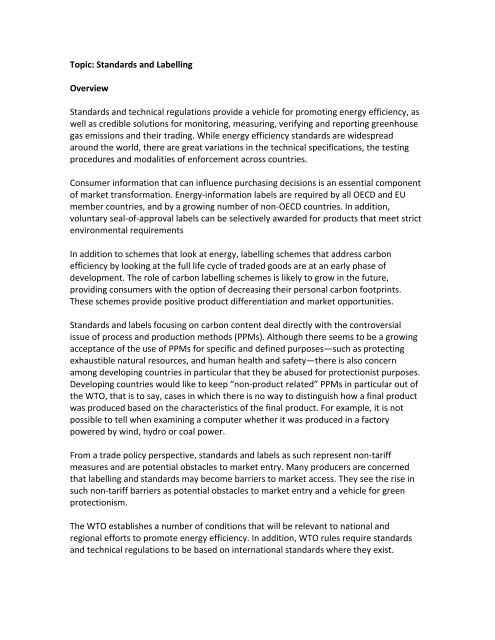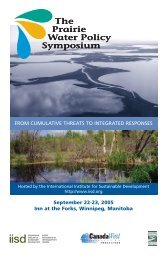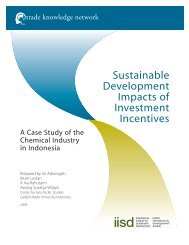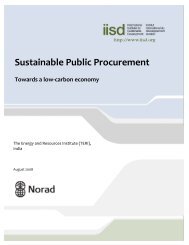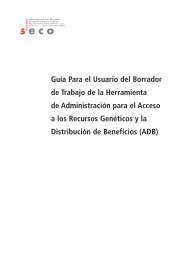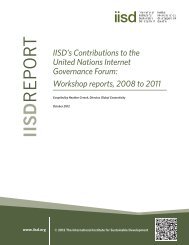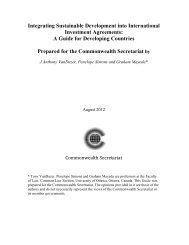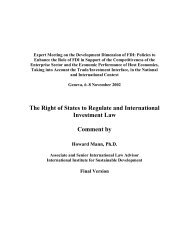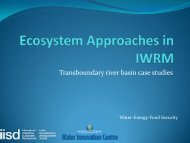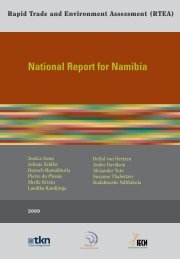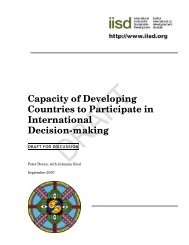Standards and Labelling - International Institute for Sustainable ...
Standards and Labelling - International Institute for Sustainable ...
Standards and Labelling - International Institute for Sustainable ...
You also want an ePaper? Increase the reach of your titles
YUMPU automatically turns print PDFs into web optimized ePapers that Google loves.
Topic: <strong>St<strong>and</strong>ards</strong> <strong>and</strong> <strong>Labelling</strong> <br />
<br />
Overview <br />
<br />
<strong>St<strong>and</strong>ards</strong> <strong>and</strong> technical regulations provide a vehicle <strong>for</strong> promoting energy efficiency, as <br />
well as credible solutions <strong>for</strong> monitoring, measuring, verifying <strong>and</strong> reporting greenhouse <br />
gas emissions <strong>and</strong> their trading. While energy efficiency st<strong>and</strong>ards are widespread <br />
around the world, there are great variations in the technical specifications, the testing <br />
procedures <strong>and</strong> modalities of en<strong>for</strong>cement across countries. <br />
<br />
Consumer in<strong>for</strong>mation that can influence purchasing decisions is an essential component <br />
of market trans<strong>for</strong>mation. Energy‐in<strong>for</strong>mation labels are required by all OECD <strong>and</strong> EU <br />
member countries, <strong>and</strong> by a growing number of non‐OECD countries. In addition, <br />
voluntary seal‐of‐approval labels can be selectively awarded <strong>for</strong> products that meet strict <br />
environmental requirements <br />
<br />
In addition to schemes that look at energy, labelling schemes that address carbon <br />
efficiency by looking at the full life cycle of traded goods are at an early phase of <br />
development. The role of carbon labelling schemes is likely to grow in the future, <br />
providing consumers with the option of decreasing their personal carbon footprints. <br />
These schemes provide positive product differentiation <strong>and</strong> market opportunities. <br />
<br />
<strong>St<strong>and</strong>ards</strong> <strong>and</strong> labels focusing on carbon content deal directly with the controversial <br />
issue of process <strong>and</strong> production methods (PPMs). Although there seems to be a growing <br />
acceptance of the use of PPMs <strong>for</strong> specific <strong>and</strong> defined purposes—such as protecting <br />
exhaustible natural resources, <strong>and</strong> human health <strong>and</strong> safety—there is also concern <br />
among developing countries in particular that they be abused <strong>for</strong> protectionist purposes. <br />
Developing countries would like to keep “non‐product related” PPMs in particular out of <br />
the WTO, that is to say, cases in which there is no way to distinguish how a final product <br />
was produced based on the characteristics of the final product. For example, it is not <br />
possible to tell when examining a computer whether it was produced in a factory <br />
powered by wind, hydro or coal power. <br />
<br />
From a trade policy perspective, st<strong>and</strong>ards <strong>and</strong> labels as such represent non‐tariff <br />
measures <strong>and</strong> are potential obstacles to market entry. Many producers are concerned <br />
that labelling <strong>and</strong> st<strong>and</strong>ards may become barriers to market access. They see the rise in <br />
such non‐tariff barriers as potential obstacles to market entry <strong>and</strong> a vehicle <strong>for</strong> green <br />
protectionism. <br />
<br />
The WTO establishes a number of conditions that will be relevant to national <strong>and</strong> <br />
regional ef<strong>for</strong>ts to promote energy efficiency. In addition, WTO rules require st<strong>and</strong>ards <br />
<strong>and</strong> technical regulations to be based on international st<strong>and</strong>ards where they exist. <br />
<br />
Related WTO agreements <br />
<br />
GATT <br />
<br />
WTO Agreement on Technical Barriers to Trade <br />
<br />
WTO Agreement on Sanitary <strong>and</strong> Phytosanitary <strong>St<strong>and</strong>ards</strong> <br />
Further reading <br />
<br />
Appleton, A. (1997). Environmental labelling programmes: Trade law implications. <br />
London: Kluwer Law <strong>International</strong>. <br />
<br />
Bernasconi‐Osterwalder, N., Magraw, D., Oliva, M.J., Orellana, M. <strong>and</strong> Tuerk, E. (2005). <br />
Environment <strong>and</strong> trade: A guide to WTO jurisprudence. London: Center <strong>for</strong> <strong>International</strong> <br />
Environmental Law (CIEL) <strong>and</strong> Earthscan <br />
www.ciel.org/Publications/Environment_<strong>and</strong>_Trade2006.pdf. <br />
<br />
Charnovitz, S. (2002). The law of environmental PPMs in the World Trade Organization: <br />
Debunking the myth of illegality. Yale Journal of <strong>International</strong> Law, 27(1): 59–110. <br />
<br />
CLASP. (2007). <strong>St<strong>and</strong>ards</strong> <strong>and</strong> labeling guidebook. Washington, D.C.: Collaborative <br />
Labeling <strong>and</strong> Appliance <strong>St<strong>and</strong>ards</strong> Program. <br />
<br />
Gaines, S.E. 2(002). Processes <strong>and</strong> production methods: How to produce sound policy <strong>for</strong> <br />
environmental PPM‐based trade measures? Columbia Journal of Environmental Law, <br />
27(2): 383–432. <br />
<br />
Howse, R. <strong>and</strong> Regan, D. (2000). The product/process distinction: An illusory basis <strong>for</strong> <br />
disciplining ‘unilateralism’ in trade policy. European Journal of <strong>International</strong> Law, 11(2): <br />
249–290. <br />
<br />
Howse, R., van Bork, P. <strong>and</strong> Hebebr<strong>and</strong>, C. (2006). WTO disciplines <strong>and</strong> biofuels: <br />
Opportunities <strong>and</strong> constraints in the creation of a global marketplace. Washington D.C.: <br />
<strong>International</strong> Food & Agriculture Trade Policy Council. <br />
www.agritrade.org/Publications/DiscussionPapers/WTO_Disciplines_Biofuels.pdf. <br />
<br />
<strong>International</strong> Energy Agency (IEA). (2003). Cool appliances: Policy strategies <strong>for</strong> energyefficient homes. Paris: IEA. <br />
<br />
IEA. (2006). Light’s labour’s lost: Policies <strong>for</strong> energy‐efficient lighting. Paris: IEA. <br />
<br />
IEA. (2007a). Mind the gap: Quantifying principal‐agent programs in energy efficiency. <br />
Paris: IEA. <br />
<br />
IEA. (2007b). Experience with energy efficiency regulations <strong>for</strong> electrical equipment. <br />
In<strong>for</strong>mation Paper. Paris: IEA. <br />
<br />
Organisation <strong>for</strong> Economic Co‐operation <strong>and</strong> Development (OECD). (1997). Processes <strong>and</strong> <br />
production methods (PPMs): Conceptual framework <strong>and</strong> considerations on use of PPMbased trade measures. OCDE/GD(97)137. Paris: OECD. <br />
Potts, J. (2008). The legality of PPMs under the GATT: Challenges <strong>and</strong> opportunities <strong>for</strong> <br />
sustainable trade policy. Winnipeg: <strong>International</strong> <strong>Institute</strong> <strong>for</strong> <strong>Sustainable</strong> Development. <br />
www.iisd.org/pdf/2008/ppms_gatt.pdf. <br />
<br />
Waide, P. (2008). Market trans<strong>for</strong>mation initiatives from around the world. Presented at <br />
the ACEEE Market Trans<strong>for</strong>mation Symposium, March 30–April 1, 2008. Washington, <br />
D.C. <br />
<br />
Sub‐topic: <strong>St<strong>and</strong>ards</strong> <strong>and</strong> labelling – Energy st<strong>and</strong>ards <strong>and</strong> labels <br />
<br />
Overview <br />
<br />
Climate change policy aims to set countries onto a path towards an efficient, low‐carbon <br />
energy future. According to the World Energy Outlook <strong>and</strong> other studies, energy <br />
efficiency improvements provide one of the most cost‐effective ways to reduce energy <br />
bills <strong>and</strong> greenhouse gas emissions, lower the cost of energy services <strong>and</strong> diminish <br />
energy import dependence. This potential is particularly important <strong>for</strong> developing <br />
countries with high energy‐import bills. <strong>St<strong>and</strong>ards</strong> <strong>and</strong> labelling are some of the most <br />
important tools to increase efficiency, <strong>and</strong> WTO rules set out the parameters <strong>for</strong> <br />
st<strong>and</strong>ards <strong>and</strong> labelling. <br />
<br />
For the time being, energy efficient end‐use technologies are still relatively underutilized <br />
because of numerous market barriers. Governments are increasingly recognizing the <br />
need to overcome these barriers through direct policy measures. The most widely <br />
deployed policies are m<strong>and</strong>atory minimum energy per<strong>for</strong>mance st<strong>and</strong>ards (MEPS) <strong>and</strong> <br />
energy labelling, both of which have been highly effective in improving equipment <br />
energy per<strong>for</strong>mance. <br />
<br />
As the large majority of energy‐using equipment is traded internationally, these policies <br />
have implications <strong>for</strong> the nature <strong>and</strong> cost of international trade. Different regional <strong>and</strong> <br />
national st<strong>and</strong>ards <strong>for</strong> testing <strong>and</strong> con<strong>for</strong>mity assessment procedures, as well as import <br />
tariff regimes, add to the cost of trading energy‐efficient products. <br />
<br />
Testing <strong>and</strong> con<strong>for</strong>mity assessment procedures are complex <strong>and</strong> reflect both historic <strong>and</strong> <br />
user difference across nations. Any multilateral decision to develop internationallyagreed criteria <strong>for</strong> relatively energy‐efficient goods, based on comparable test <br />
procedures, would need to be justified by the expectation that the net benefits of <br />
increased trade in goods outweigh the inconvenience of harmonization. Future energy <br />
st<strong>and</strong>ards <strong>and</strong> labelling schemes would need to balance the need <strong>for</strong> accurate <strong>and</strong> useful <br />
data with the need to be simple, transparent, <strong>and</strong> involve sufficiently low transaction <br />
costs to include small countries <strong>and</strong> players. <br />
Key issues <br />
<br />
The development <strong>and</strong> dissemination of new <strong>and</strong> efficient energy technologies provides <br />
one important element in the levelling off of the current energy growth trends, <br />
contributing to the reduction of emissions from energy use. <strong>St<strong>and</strong>ards</strong> <strong>and</strong> technical <br />
regulations provide a vehicle <strong>for</strong> promoting energy efficiency. According to the <br />
<strong>International</strong> Energy Agency, accelerated energy efficiency improvement is credited with <br />
78 per cent of the emissions reduction savings potential by 2030, making it critical <strong>for</strong> a <br />
future climate regime to harness that potential. <br />
<br />
Trade in energy‐efficient products <br />
<br />
Given that the vast majority of energy‐using equipment <strong>and</strong> consumer products are <br />
traded globally, an important question is how markets can be made to work better <strong>for</strong> <br />
the scaling up of energy efficiency. A global trade‐led market trans<strong>for</strong>mation ef<strong>for</strong>t <br />
would require exp<strong>and</strong>ing markets <strong>for</strong> more advanced technologies, while eliminating <br />
outdated equipment. M<strong>and</strong>atory minimum energy per<strong>for</strong>mance st<strong>and</strong>ards (MEPS) aim to <br />
push up the efficiency level of new products entering the market. Governments can take <br />
these a step further by phasing out older technologies <strong>and</strong> products that use more <br />
energy <strong>and</strong> produce more greenhouse gas emissions. Examples include replacing <br />
inc<strong>and</strong>escent light bulbs with more energy‐efficient compact fluorescent lamps, which <br />
use only about 20 per cent of the power to produce the same amount of light <strong>and</strong> last <br />
longer. Energy in<strong>for</strong>mation labels can help consumers made climate‐friendly purchasing <br />
decisions. <br />
<br />
Energy per<strong>for</strong>mance st<strong>and</strong>ards <br />
<br />
Several countries have taken steps aimed at directing energy‐per<strong>for</strong>mance st<strong>and</strong>ards <strong>for</strong> <br />
a range of consumer appliances. M<strong>and</strong>atory minimum energy‐per<strong>for</strong>mance st<strong>and</strong>ards <br />
(MEPS) have been introduced in most OECD countries, but also in many developing <br />
countries. In 2006, 57 countries representing 80 per cent of the world’s population had <br />
energy‐efficiency st<strong>and</strong>ards <strong>and</strong> labelling programs in place. <br />
<br />
Minimum energy‐per<strong>for</strong>mance requirements have taken various <strong>for</strong>ms in different <br />
countries, with MEPS often coupled with more stringent st<strong>and</strong>ards or by more <br />
restrictive, voluntary agreements between government <strong>and</strong> industry. <br />
<br />
<strong>Labelling</strong> <br />
<br />
Consumer in<strong>for</strong>mation that can influence purchasing decisions is an essential component <br />
of market trans<strong>for</strong>mation. Most countries that regulate MEPS also require energyin<strong>for</strong>mation labels to be displayed on the same products. Energy‐in<strong>for</strong>mation labels are <br />
required by all OECD <strong>and</strong> EU member countries, <strong>and</strong> by a growing number of non‐OECD <br />
countries.
<br />
The main piece of in<strong>for</strong>mation provided by a m<strong>and</strong>atory energy‐in<strong>for</strong>mation label is the <br />
appliance’s estimated energy consumption in kWh/year, or per operating cycle derived <br />
from st<strong>and</strong>ard tests. The label typically shows the product group type <strong>and</strong> size category <br />
within which the model should be compared, as well as the energy consumption of the <br />
most <strong>and</strong> least energy efficient models within the product group <strong>for</strong> comparison. <br />
Increasingly popular are the use of visual aids, such as the EU’s colour‐coded <br />
per<strong>for</strong>mance scale from G (lowest efficiency) to A (Highest efficiency), to increase quick <br />
comparison between different appliances <strong>and</strong> to identify the most efficient models. <br />
<br />
In addition, voluntary seal‐of‐approval labels can be selectively awarded <strong>for</strong> products <br />
that meet strict environmental requirements. Ecological or environmental labelling <br />
schemes (“eco‐labels”) often augment energy‐efficiency criteria with other product <br />
per<strong>for</strong>mance criteria, such as <strong>for</strong> noise, water use or product durability, specifications <br />
relating to the composition of the product or the product’s re‐use, recycling <strong>and</strong> disposal <br />
characteristics. <br />
<br />
Harmonizing st<strong>and</strong>ards <strong>and</strong> labels internationally <br />
<br />
While energy‐efficiency st<strong>and</strong>ards are widespread around the world, there are great <br />
variations in the technical specifications, the testing procedures <strong>and</strong> modalities of <br />
en<strong>for</strong>cement across countries. Such differences are recognized in the climate <br />
Convention, which notes in its preamble that " environmental st<strong>and</strong>ards […] should <br />
reflect the environmental <strong>and</strong> developmental context to which they apply, <strong>and</strong> that <br />
st<strong>and</strong>ards applied by some countries may be inappropriate <strong>and</strong> of unwarranted <br />
economic <strong>and</strong> social cost to other countries, in particular developing countries." <br />
<br />
An ef<strong>for</strong>t towards harmonization of energy efficiency st<strong>and</strong>ards would generate greater <br />
coherence at the international level. Whether that can be achieved under the UNFCCC <br />
umbrella or through other <strong>for</strong>ums, such as the <strong>International</strong> <strong>St<strong>and</strong>ards</strong> Organisation <br />
(ISO), requires further consideration. Overall, views diverge on the desirability <strong>and</strong> need <br />
<strong>for</strong> harmonization of energy st<strong>and</strong>ards at the international level. Some argue that this is <br />
a sphere <strong>for</strong> “regulatory competition” where consumers play an arbitration function. <br />
Others point out that in aligning processes <strong>for</strong> setting <strong>and</strong> testing st<strong>and</strong>ards, policymakers should take care not to threaten legitimate functional distinctions <strong>and</strong> the <br />
integrity of st<strong>and</strong>ards <strong>and</strong> labelling schemes. <br />
<br />
<strong>St<strong>and</strong>ards</strong> <strong>and</strong> labels as non‐tariff barriers <br />
<br />
From a trade policy perspective, st<strong>and</strong>ards <strong>and</strong> labels represent non‐tariff measures <strong>and</strong>, <br />
as such, are potential obstacles to market entry. Different efficiency st<strong>and</strong>ards <strong>and</strong> <br />
labels, as well as test procedures, are reported to be the most frequent concern of the <br />
WTO under the Agreement on Technical Barriers to Trade. WTO rules, through <br />
disciplines on areas such as subsidies, border measures <strong>and</strong> technical requirements,
there<strong>for</strong>e have implications <strong>for</strong> the options available to countries in implementing <br />
climate measures <strong>and</strong> promoting the use of energy‐efficient products. <br />
<br />
However, st<strong>and</strong>ards <strong>and</strong> labelling schemes also provide opportunities <strong>for</strong> positive <br />
product differentiation <strong>and</strong> market opportunities. In general, WTO rules require <br />
st<strong>and</strong>ards <strong>and</strong> technical regulations to be based on international st<strong>and</strong>ards where they <br />
exist. <br />
<br />
Sub‐topic: <strong>St<strong>and</strong>ards</strong> <strong>and</strong> labelling – Carbon labels <br />
<br />
Overview <br />
<br />
The carbon embedded in internationally traded goods—its measurement, as well as <br />
different ways of communicating the climate impact—is a rapidly emerging factor <br />
expected to significantly influence consumer behaviour in major markets across the <br />
globe. Changing consumption patterns will be important within the wide spectrum of <br />
measures needed to address climate change. New, mainly private‐sector driven carbon <br />
labelling schemes raise a number of issues, however. They will affect a wide range of <br />
stakeholders, including producers <strong>and</strong> consumers, the public <strong>and</strong> private sector, <strong>and</strong> <br />
developing <strong>and</strong> developed countries, along all levels of globally‐distributed value chains. <br />
So far, public scrutiny <strong>and</strong> debate around carbon labelling has been limited. <br />
<br />
While the intergovernmental processes under the UNFCCC <strong>and</strong> the Doha Round are <br />
advancing at a slow pace, carbon labelling schemes as well as initiatives to measure <br />
carbon <strong>and</strong> address carbon hotspots within the value chains of globally traded goods, <br />
both agricultural <strong>and</strong> industrial, are moving ahead. The measurement of the carbon <br />
embedded within individual products is rapidly becoming more sophisticated—<strong>and</strong> is <br />
certainly costly. Early experiments, which largely singled out the “carbon hotspot” airfreighting of fresh fruits <strong>and</strong> flowers entailed <strong>and</strong> communicated this through airplane <br />
stickers, have been largely discredited. Newer initiatives seek to underst<strong>and</strong> the full <br />
lifecycle of any given good. However, drawing the boundaries <strong>for</strong> such lifecycle analysis <br />
becomes close to impossible. And yet, simplifications must be made to render any <br />
scheme workable, <strong>and</strong> costs bearable—especially <strong>for</strong> smaller producers. <br />
<br />
For developing country players to be able to participate in the schemes, technical <br />
assistance <strong>and</strong> support targeting smaller producers in particular would be needed. <br />
Transparency is important to allay fears that the schemes are just the newest in a <br />
seemingly never‐ending stream of developed country non‐tariff barriers used as green <br />
protectionism. Depending on how carbon‐labelling schemes are developed, they could <br />
well provide new market opportunities <strong>and</strong> niches <strong>for</strong> developing countries based on <br />
carbon efficiency. <br />
<br />
Meanwhile, <strong>for</strong> consumers to trust new carbon labels, they must be developed in an <br />
open <strong>and</strong> transparent manner, with clarity around what greenhouse gas emissions they <br />
account <strong>for</strong>, <strong>and</strong> which ones they do not—how they interact with other social <strong>and</strong> <br />
environmental st<strong>and</strong>ards, <strong>and</strong> how they affect development opportunities in developing <br />
countries. However, they must also be simple to underst<strong>and</strong> in order to be relevant. <br />
Key issues <br />
<br />
The food miles debate <br />
<br />
Simply put, food miles are the distance that food travels from the field where it was <br />
grown to the plate where it is consumed. The objective in measuring these distances is to <br />
determine the environmental impact based on the carbon emitted during transport, <br />
whether by air, sea, lorry or car. Most bulk products are shipped by sea; fresh produce, <br />
however, needs to reach the consumer quickly <strong>and</strong> airfreight is the only option. The <br />
carbon emissions associated with air‐freighted products are high—177 times greater <br />
than <strong>for</strong> products being shipped by sea. This means that mangos from Brazil, <br />
strawberries from Kenya <strong>and</strong> asparagus from Mexico being sent to European <br />
supermarkets have a significant environmental impact based on the miles they have <br />
travelled to reach their final destination. Among all food products transported <br />
internationally, the most miles are clocked by such out‐of‐season fruits <strong>and</strong> vegetables <br />
arriving from distant countries. <br />
<br />
For many governments, supermarkets, <strong>and</strong> even some environmental advocates, the <br />
simple solution to reducing the carbon miles generated by food travel is to buy locally. In <br />
supermarkets throughout Europe, fresh produce from abroad is being labelled with a <br />
sticker depicting an airplane to alert consumers that it was imported via air freight. The <br />
policy behind this labelling is to encourage consumers to purchase local products <strong>and</strong> <br />
also to provide incentives to the company itself to source as much food locally as <br />
possible, to grow local supply networks <strong>and</strong> to offset carbon emissions from air‐freighted <br />
products. <br />
<br />
Problems with food miles <br />
<br />
In most countries, even food produced nationally travels extensively be<strong>for</strong>e getting to <br />
retailers. While these trips are made by lorry as opposed to airplane, the carbon emitted <br />
during cross‐country tours is not negligible. Add in the cars used by most consumers to <br />
get from their homes to the market, <strong>and</strong> the carbon footprint is on par with that of airfreighted products. <br />
<br />
Another major challenge with buying local is that transport is only part of the equation. <br />
Agricultural methods used in producing food, the types of processing manufacturers use, <br />
<strong>and</strong> storage methods also play an important role. Studies have shown, <strong>for</strong> instance, that <br />
lamb grown in the U.K. <strong>and</strong> sold locally has a greater carbon footprint than lamb grown <br />
in New Zeal<strong>and</strong>, 11,000 miles away. This is because New Zeal<strong>and</strong> uses more energyefficient <strong>and</strong> environmentally‐friendly methods <strong>for</strong> raising its lamb than the U.K. does. <br />
<br />
Beyond the environmental aspects of food miles, there are social implications to be <br />
considered. Development advocates say it does not make sense to halt air‐freighted <br />
products <strong>and</strong> encourage local food production, as this would hurt the poorest suppliers
in least‐developed <strong>and</strong> developing countries that rely heavily on revenue from exported <br />
products. Growing fresh produce provides a crucial source of income <strong>for</strong> the poorest of <br />
the poor in these already vulnerable countries, <strong>and</strong> countless livelihoods would be at <br />
stake. The fresh fruit <strong>and</strong> vegetable trade with the U.K., <strong>for</strong> instance, generates US$400 <br />
million, which supports one million people living in Africa. If developed countries were to <br />
buy only locally, the development implications would be significant. <br />
<br />
Carbon lifecycle analysis <br />
<br />
The failure of the “food miles” concept to account <strong>for</strong> social implications has caused <br />
many in the trade <strong>and</strong> development community to critique the concept. So too have <br />
some environmentalists that believe the idea is too simplistic in its focus on carbon <br />
emitted solely during transport. These critics are instead calling <strong>for</strong> a full life‐cycle <br />
analysis (LCA) of the carbon footprint; that is, measuring the carbon emissions from the <br />
field to the plate by accounting <strong>for</strong> agricultural methods, processing, energy, soil, <br />
distribution <strong>and</strong> everything in between. The full life cycle is a kind of cradle‐to‐grave <br />
approach <strong>for</strong> determining the carbon impact of foodstuffs. As this calculation is based <br />
not only on miles travelled but on carbon emitted during the entire production process, <br />
it is less likely to discriminate against developing country exports the way food miles <br />
schemes have done. <br />
<br />
Some companies <strong>and</strong> supermarket chains have started implementing carbon labelling <br />
programs based on LCA, <strong>and</strong> are moving from agricultural products (with simple value <br />
chains) to also include more complex industrial products. <br />
<br />
<strong>Labelling</strong> st<strong>and</strong>ards that ensure consistency <strong>and</strong> comparability among products carrying <br />
the tag are being created by the Carbon Trust, a private company established by the U.K. <br />
government to help Britain move towards a low carbon economy. The Carbon Trust is <br />
working to develop an agreed method to measure the embodied greenhouse gases <br />
among a wide range of products. Once calculated, the label will show the amount of <br />
carbon in grams much like the nutrition label provides the amount of sodium or fat in <br />
foods. <br />
<br />
The st<strong>and</strong>ards <strong>and</strong> the labels are still in their trial stages. Once the st<strong>and</strong>ard is in place, <br />
manufacturers can voluntarily sign up to have their products carry the label. The process <br />
of certification <strong>and</strong> monitoring will be h<strong>and</strong>led by independent companies to ensure that <br />
manufactures are adhering to the st<strong>and</strong>ards. <br />
<br />
Private sector st<strong>and</strong>ards <strong>and</strong> the WTO <br />
<br />
Carbon labelling schemes developed thus far have all been initiated by the private sector. <br />
Within the WTO Committee on Sanitary <strong>and</strong> Phytosanitary <strong>St<strong>and</strong>ards</strong> (SPS), debate is <br />
ongoing on these types of st<strong>and</strong>ards, which some Members consider to be the new
frontier of protectionism. As actual trade tariffs come down, these types of non‐tariff <br />
barriers take their place. <br />
<br />
A number of developing countries, in particular, have been highly critical of the use of <br />
private sector st<strong>and</strong>ards, arguing that they reduce the efficacy of the SPS regime by <br />
creating higher st<strong>and</strong>ards outside of government control. These countries stress that the <br />
st<strong>and</strong>ards are arbitrary <strong>and</strong> end up penalizing developing countries <strong>and</strong> small farmers <br />
exporting to the North since they lack capacity <strong>and</strong> funding to comply. Many developing <br />
countries argue that governments should to take responsibility <strong>for</strong> st<strong>and</strong>ards set by <br />
private‐sector actors within their boundaries. Others, especially developed countries, say <br />
that private sector st<strong>and</strong>ards fall outside the remit of the WTO <strong>and</strong> its SPS Agreement. <br />
Under the Agreement on Technical Barriers to Trade (TBT), which would appear to apply <br />
more directly to carbon labelling initiatives, private sector labelling schemes are covered <br />
in addition to public labelling schemes. However, there is no ongoing debate on the topic <br />
within the TBT Committee. <br />
Sub‐topic: <strong>St<strong>and</strong>ards</strong> <strong>and</strong> labelling – PPMs <br />
<br />
Overview <br />
<br />
Discussions <strong>and</strong> developments at the trade <strong>and</strong> climate change interface touch directly <br />
on the issue of how the WTO deals with process <strong>and</strong> production methods (PPMs). One of <br />
the key principles underpinning the WTO is that Members cannot discriminate among <br />
“like” products, no matter in which Member nation they are produced. In order to make <br />
distinctions regarding the carbon impact of a product, they way it was produced is key. <br />
However, this is not always obvious just by looking at the final product itself—is it “like” <br />
or “unlike” a similar product <strong>for</strong> which massive amounts of greenhouse gases were <br />
released during production? <br />
<br />
Taking PPMs into consideration implies looking beyond the borders of countries at <br />
production issues. Many countries—especially developing ones—feel this unjustly <br />
impinges on sovereignty. They feel concerned especially because most PPM‐based <br />
st<strong>and</strong>ards <strong>and</strong> labels are imposed by rich developed countries <strong>and</strong> have the potential <br />
negatively affect the exports of developing countries. The issue is relevant not only <strong>for</strong> <br />
carbon st<strong>and</strong>ards <strong>and</strong> labelling initiatives, but also within the Doha Round negotiations <br />
on the liberalization of environmental goods <strong>and</strong> services, including climate‐friendly <br />
goods. <br />
<br />
WTO jurisprudence does, however, seem to imply that the use of PPMs is legal, as long <br />
as the country restricting imports based on PPMs has made ef<strong>for</strong>ts to ensure that the <br />
restrictions are fair, transparent <strong>and</strong> based on a cooperative approach. As such, an <br />
importing country is not imposing its own st<strong>and</strong>ards <strong>and</strong> norms on other countries, but <br />
rather making sure that products entering its own territory con<strong>for</strong>m to such norms. Here, <br />
it would appear to be important that the way the exporter chooses to con<strong>for</strong>m with the <br />
norms is not restricted, but that the exporter can embark on its own path to achieve the <br />
same goals. For example, process‐related greenhouse gas restrictions can be achieved in <br />
a wide variety of ways. This is recognized under the UNFCCC, which allows countries to <br />
choose themselves what policies <strong>and</strong> measures to use to achieve climate goals. <br />
Key issues <br />
<br />
Competitiveness <strong>and</strong> border adjustments <br />
<br />
Beyond being directly applicable to carbon labelling schemes <strong>and</strong> certain climate <strong>and</strong> <br />
energy‐related st<strong>and</strong>ards, PPMs also play a role in other climate measures countries are <br />
contemplating to tackle climate change. As some countries take on stricter climate <br />
targets than others, they will implement a wide range of policies <strong>and</strong> measures to <br />
implement these targets. These policies will often make production in these countries <br />
more expensive due to higher energy prices, requirements to buy carbon credits under <br />
emissions trading schemes, <strong>and</strong> so <strong>for</strong>th. Countries are there<strong>for</strong>e concerned that by <br />
taking on climate change commitments, they will put their industries—at least the <br />
energy <strong>and</strong> carbon‐intensive ones—at a disadvantage. <br />
<br />
For this reason, they are looking to take measures to ensure that their exports are not <br />
penalized on the global markets, <strong>and</strong> to avoid “leakage,” that is, relocation of <br />
greenhouse gas intensive industries to slacker jurisdictions with associated higher overall <br />
greenhouse gas emissions. They are looking at different options, such as different types <br />
of border adjustments that would level the carbon playing field. Such adjustments would <br />
have to directly factor in PPMs. <br />
<br />
Current discussions on “embedded” carbon also relate directly to PPMs. This refers to <br />
the fact that carbon emissions related to the production of a good are accounted <strong>for</strong> in <br />
the country of manufacture, not consumption, in national carbon inventories under the <br />
UNFCCC. Some have argued that carbon accounting systems should be revised on this <br />
point, though any practical ef<strong>for</strong>t to move in this direction remains daunting. <br />
<br />
Certification schemes <br />
<br />
Closely linked to carbon labelling schemes, schemes certifying traded goods from a <br />
carbon vantage point <strong>and</strong> taking on‐board additional sustainability criteria are on the <br />
rise. For example, the EU is planning a certification scheme <strong>for</strong> biofuels that will set <br />
sustainability requirements beyond carbon impact, including secondary impacts on l<strong>and</strong> <br />
use <strong>and</strong> biodiversity, <strong>and</strong> requiring producers to be parties to a number of international <br />
agreements on environmental <strong>and</strong> labour issues (the latter in particular being a longst<strong>and</strong>ing controversial issue <strong>for</strong> developing countries, <strong>and</strong> a major reason they have <br />
tended to oppose bringing PPMs within the WTO). Major producer countries have <br />
already threatened to challenge this scheme at the WTO. If this were to happen, the <br />
systemic implications of a ruling would be wide ranging. <br />
<br />
Meanwhile, a number of private sector certification schemes on biofuels are already up <br />
<strong>and</strong> running, <strong>and</strong> many companies from countries opposed to official biofuels <br />
certification schemes have signed on <strong>and</strong> helped develop them. Indeed, one of the <br />
problems appears to be the proliferation of different <strong>and</strong> partially overlapping schemes,
which will be difficult especially <strong>for</strong> smaller producers <strong>and</strong> countries to navigate, <br />
influence <strong>and</strong> make use of. <br />
<br />
Discrimination <strong>and</strong> inclusiveness <br />
<br />
Developing countries have opposed the use of process <strong>and</strong> production methods on the <br />
basis that it would create a de facto trade barrier <strong>for</strong> them, since it is only the wealthier <br />
countries that would have high st<strong>and</strong>ards <strong>and</strong> complex PPM‐based labelling schemes, <br />
<strong>and</strong> only they have the financial <strong>and</strong> technical resources to comply with them. <br />
<br />
However, in some cases developing countries might actually have an advantage in terms <br />
of producing cleaner goods through cleaner processes—<strong>and</strong> the possibility to capture <br />
new markets. However, in order to make use of any such opportunities, developing <br />
countries need to be involved in st<strong>and</strong>ard‐setting <strong>and</strong> labelling processes. In this regard, <br />
technical assistance could be provided both under the WTO <strong>and</strong> UNFCCC. <br />


